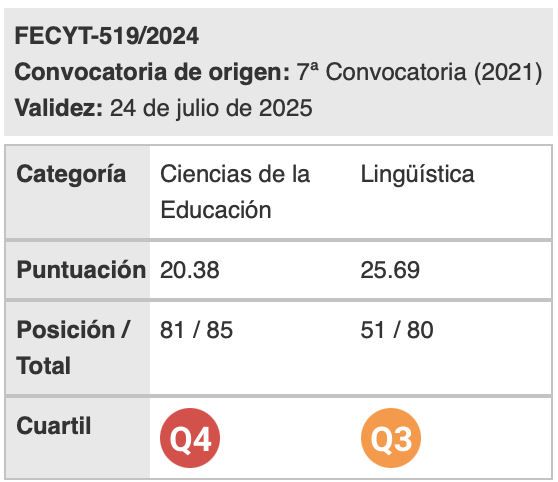Learning motivation and strategies of ESP university students
Palabras clave:
English Learning Motivation, English Learning Strategies, English for Specific Purposes (ESP), ESP courses, engineering studentsResumen
This paper deals with two of the key factors in the L2 learning process, namely, learning motivation and strategies. A group of engineering students from Bilbao (Spain) having a good command of English for General Purposes (EGP) and taking a course in English for Specific Purposes (ESP) are the basis of a study in which types of English Learning Motivation (ELM), i.e. intrinsic and extrinsic (integrative and instrumental) (Brown, 2000), and types of English Learning Strategies (ELSs), i.e. memory, cognitive, compensation, metacognitive, affective and social strategies (Oxford, 1990), are analysed. As expected, Instrumental ELM and Cognitive and Metacognitive ELSs are the most widely used by these learners. However, some striking and significant differences appear in connection with: 1) male vs female Intrinsic ELM and Social ELSs; 2) 21-23 vs 24-27 age group Instrumental (EGP) ELM, and Metacognitive and Social ELSs. Finally, with respect to the prospective correlation between ELM and ELS types, the results seem to confirm that there are signicant correlations among most of them; e.g., Instrumental (ESP) ELM is positively and significantly correlated with all but Affective ELM.Descargas
Citas
Bacon, S. M., & Finnemann, M. D. (1990). A study of the attitudes, motives, and strategies of university foreign language students and their disposition to authentic oral and written input. Modern Language Journal, 74(4), 459-473.
Baker, C. (2006). Foundations of Bilingual Education and Bilingualism. Clevedon, England: Multilingual Matters Ltd.
Bell, C. (2006). Specialised vocabulary. English Teaching Professional, 42, 35-36.
Bernaus, M., Masgoret, A., Gardner, R. C., & Reyes, E. (2004). Motivation and attitudes towards learning languages in multicultural classrooms. The International Journal of Multilingualism, 2, 75-89.
Bernaus, M., & Gardner, R. C. (2008). Teacher motivation strategies, student perceptions, student motivation, and English achievement. The Modern Language Journal, 92, 387–401.
Brewer, E. W., & Burgess, D. N. (2005). Professor’s role in motivating students to attend class. Journal of Industrial Teacher Education, 42(3), 23-47.
Brown, H. D. (2000). Principles of Language Teaching and Learning. White Plains, NY: Longman.
Chamot, A. U. (1987). The learning strategies of ESL students. In A. Wenden & J. Rubin (Eds.), Learner Strategies in Language Learning (pp. 71-84). Englewood Cliffs, NJ: Prentice Hall.
Chamot, A. U. (2001). Teaching learning strategies in immersion classrooms. The ACIE Newsletter, 5(1), 1-8. <http://www.carla.umn.edu/immersion /acie/vol5/Nov2001.pdf> [23/11/2015].
Clayton, K., Blumberg, F., & Auld, D. P. (2010). The relationship between motivation, learning strategies and choice of environment whether traditional or including an online component. British Journal of Educational Technology, 41(3), 349–364.
Cohen, A. D. (1998). Strategies in Learning and Using a Second Language. London: Longman.
Csizér, K., & Dörnyei, Z. (2005). Language learners’ motivational profiles and their motivated learning behavior. Language Learning, 55(4), 613-659.
Dewaele, J.-M. (2005). Investigating the psychological and emotional dimensions in instructed language learning: obstacles and possibilities. The Modern Language Journal, 89(3), 367-380.
Dörnyei, Z. (2003) Questionnaires in Second Language Research. Muhwah, NJ: Lawrence Erlbaum.
Dörnyei, Z. (2005). The Psychology of the Language Learner: Individual Differences in Second Language Acquisition. Mahwah, NJ: Lawrence Erlbaum.
Dörnyei, Z., & Ushioda, E. (2011). Teaching and Researching Motivation (2nd ed.). Harlow, England: Pearson Longman.
Dreyer, C., & Oxford, R. (1996). Learning strategies and other predictors of ESL proficiency among Afrikaans-speakers in South Africa. In R. Oxford (Ed.), Language Learning Strategies Around the World: Cross-cultural Perspectives (pp. 61-74). Manoa, HI: University of Hawaii Press.
Eagly, A. H., & Chaiken, S. (2007). The advantages of an inclusive definition of attitude. Social Cognition, 25(5), 582-602.
Flemenig, F., & Walls, G. (1998). What pupils do: the role of strategic planning in modern foreign language learning. Language Learning, 18, 14-21.
Gardner, R. C. (2010). Motivation and Second language acquisition. The Socio-educational Model. New York, NY: Peter Lang Publishing.
Gardner, R. C., & Lambert, W. E. (1972). Attitudes and Motivation in Second Language Learning. Rowley, MA: Newbury House.
Gardner, R. C., & MacIntyre, P. D. (1993). A student’s contribution to second language learning: Part II, affective factors. Language Teaching, 26, 1-11.
Gardner, R. C., & Tremblay, P. F. (1998). Specificity of affective variables and the trait/state conceptualization of motivation in second language acquisition. In R. Agnihotri, A. L. Khanna & I. Sachdev (Eds.), Social Psychological Perspectives on Second Language Learning (pp. 31-52). New Delhi, India: Sage.
Horwitz, E. K. (1999). Cultural and situational influences on foreign language learners’ beliefs about language learning: a review of BALLI studies. System, 27(4), 557–576.
Irizar, T., & Chiappy, A. (2008). Operational level 4: A Cuban project. Professional and Academic English, 32, 12-17.
Kormos, J. (2008). Language Learners with Special Needs: An International Perspective. Bristol, England: Multilingual Matters.
Krashen, S. (2013). Should we teach strategies? The Electronic Journal of Foreign Language Teaching, 10(1), 35–39.
Lan, R., & Oxford, R. L. (2003). Language learning strategy profiles of elementary school students in Taiwan. IRAL, 41, 339–379.
Larsen-Freeman, D., & Long, M. H. (1991). An Introduction to Second Language Acquisition Research. London, England: Longman.
Lasagabaster, D. (2011). English achievement and student motivation in CLIL and EFL settings. Innovation in Language Learning and Teaching, 5, 3-18.
Liyanage, I., & Bartlett, B. (2013). Personality types and languages learning strategies: Chameleons changing colours. System, 41(3), 598-608.
Masgoret, A. M., & Gardner, R. C. (2003). Attitudes, motivation, and second language learning. A meta-analysis of studies conducted by Gardner and associates. Language Learning, 53, 123-163.
Norris-Holt, J. (2001). Motivation as a contributing factor in second language acquisition. The Internet TESL Journal, 7(6). <http://iteslj.org/Articles/Norris-Motivation.html> [14/11/2015].
O’Malley, J. M., Chamot, A. U., Stewner-Manzanares, G., Russo, R. P., & Kupper, L. (1985). Learning strategy applications with students of English as a second language. TESOL Quarterly, 19(3), 557-584.
O’Malley, J. M., & Chamot, A. U. (1993). Learning Strategies in Second Language Acquisition. New York, NY: Cambridge University Press.
Oxford, R. L. (1990). Language Learning Strategies. New York, NY: Newbury House.
Oxford, R. L. (2003). Language learning styles and strategies: Concepts and relationships. International Review of Applied Linguistics in Language Teaching (Iral), 41, 271-277.
Oxford, R. L., & Nyikos, M. (1989). Variables affecting choice of language learning strategies by university students. The Modern Language Journal, 73(3), 291-300.
Oxford, R. L., & Green, J. M. (1996). Language learning histories: Learners and teachers helping each other understand learning styles and strategies. TESOL Journal, 3, 20- 23.
Pintrich, P. R., & Schunk, D. H. (2002). Motivation in Education: Theory, Research and Applications. Upper Saddle River, NJ: Merril Prentice-Hall.
Rivers, W. P. (2001). Autonomy at all costs: An ethnography of metacognitive Self-Assessment and Self-Management among experienced language learners. The Modern Language Journal, 85(2), 279-290.
Robinson, P. (2005). Aptitude and second language acquisition. Annual Review of Applied Linguistics, 25, 45-73.
Rose, H. (2012). Language learning strategy research: Where do we go from here? Studies in Self-Access Learning Journal, 3(2), 137-148.
Ryan, R. M., & Deci, E. L. (2000a). Self-determination theory and the facilitation of intrinsic motivation, social development and well-being. American Psychologist, 55, 68-78.
Ryan R. M., & Deci, E. L. (2000b). Intrinsic and extrinsic motivations: Classic definitions and new directions. Contemporary Educational Psychology, 25, 54-67.
Sakai, H., & Kikuchi, K. (2009). An analysis of demotivators in the EFL classroom. System, 37(1), 57-69.
Sansone, C., & Harackiewicz, J. M. (2000). Looking beyond rewards: The problem and promise of intrinsic motivation. In C. Sansone & J. M. Harackiewicz (Eds.), Intrinsic and Extrinsic Motivation: The Search for Optimal Motivation and Performance (pp. 1-9). San Diego, CA: Academic Press. Published.
Schmidt, R., Boraie, D., & Kassabgy, O. (1996). Foreign language motivation: Internal structure and external connections. In R. L. Oxford (Ed.), Language Learning Motivation: Pathways to the New Century (pp. 9-70). Honolulu, HI: University of Hawaii, National Foreign Language Resource Center.
Schmidt, N., & Celce Murcia, M. (2002). An overview of applied linguistics. In N. Schmitt (Ed.). An Introduction to Applied Linguistics (pp. 1-18). London: Edward Arnold.
Skehan, P. (1989). Individual Differences in Second-Language Learning. London, England: Edward Arnold.
Valcárcel, M., Coyle, Y., & Verdú, M. (1996). Learning foreign languages: Learner strategies. In N. McLaren & D. Madrid (Eds.), A Handbook for TEFL (pp. 65-106). Alcoy, Alicante: Marfil.
Walker, C., Greene, B., & Mansell, R. (2006). Identification with academics, intrinsic/extrinsic motivation, and self-efficacy as predictors of cognitive engagement. Learning and Individual Differences, 16(1), 1- 12.
Descargas
Publicado
Cómo citar
Número
Sección
Licencia
Aquellos autores/as que tengan publicaciones con esta revista, aceptan los términos siguientes:
- Los autores/as conservarán sus derechos de autor y garantizarán a la revista el derecho de primera publicación de su obra, el cuál estará simultáneamente sujeto a la Licencia de reconocimiento de Creative Commons que permite a terceros compartir la obra siempre que se indique su autor y su primera publicación esta revista.
- Los autores/as podrán adoptar otros acuerdos de licencia no exclusiva de distribución de la versión de la obra publicada (p. ej.: depositarla en un archivo telemático institucional o publicarla en un volumen monográfico) siempre que se indique la publicación inicial en esta revista.
- Se permite y recomienda a los autores/as difundir su obra a través de Internet (p. ej.: en archivos telemáticos institucionales o en su página web) antes y durante el proceso de envío, lo cual puede producir intercambios interesantes y aumentar las citas de la obra publicada. (Véase El efecto del acceso abierto).

Revista de Lenguas para fines específicos is licensed under a Creative Commons Reconocimiento-NoComercial-SinObraDerivada 4.0 Internacional License.






















